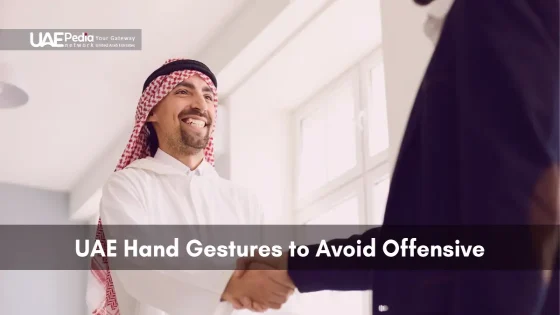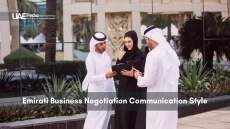“If you tie up an Arab’s hands,” warns a local proverb, “you might as well have tied up his tongue.” Here, every gesture carries weight—a raised pinky, an open palm, even how you pass a business card. Get it right, and you’ll navigate social moments like a seasoned insider. Miss the mark? Well, let’s just say it’s easier to learn the rules than undo a clumsy first impression.
Non-verbal communication isn’t just polite in this part of the world—it’s woven into centuries of tradition. Bedouin traders once relied on subtle ishara (signs) to negotiate deals across desert silence. Today, that legacy lives in everything from greetings to gift-giving. One golden rule? The right hand reigns supreme for eating, shaking hands, or exchanging items—a nod to historical hygiene practices still respected nationwide.
But don’t stress! With a few mindful adjustments, you’ll master the art of respectful interaction. This guide walks you through the essentials—from avoiding accidental slights to nailing that perfect salaam (peace) when meeting locals. Consider it your backstage pass to building trust through body language.
- Non-verbal cues are deeply rooted in Arab heritage and daily etiquette
- Prioritize using your right hand for gestures and exchanges
- Subtle movements often convey more than words in social settings
Understanding UAE Cultural Etiquette and Body Language
Picture this: a raised eyebrow replacing a “no,” or a warm smile conveying more than words ever could. In this corner of the world, body language isn’t just a supplement to conversation—it’s the main event. Bedouin roots still shape how people express respect, share hospitality, or signal disagreement without uttering a syllable.
The Unspoken Language of Respect
While Westerners might greet strangers with casual high-fives, Arab culture treats every interaction as layered communication. A firm handshake here isn’t just polite—it’s a sign of trust. Business cards? Always presented with the right hand, never tossed onto a table. Even how you sit (feet flat, never crossed) sends silent messages about your intentions.
When East Meets West in Greetings
Tourists often stumble over differences like nose-rubbing between men (a traditional Bedouin hello) versus quick nods for women. Time plays tricks too—what’s acceptable during Friday prayers might differ from a weekday market visit. Pro tip: let locals initiate physical contact, and mirror their energy. As one Dubai expat told me, “Your body speaks first here—make sure it’s telling the right story.”
Read More:
Fundamental UAE Hand Gestures in Daily Life
Ever watched someone fumble a coffee cup transfer? Now imagine that tension magnified tenfold. In this culture, how you hold a business card or accept a date-stuffed pastry speaks volumes. A local etiquette coach once told me, “Your palms are diplomats—let them negotiate peace before your words even land.”
The Right-Hand Rule and Proper Use of Hands
Three reasons make the right hand the MVP here:
- Historical hygiene: Centuries-old practices linked to cleanliness rituals
- Symbolic respect: Considered the “clean” side for social exchanges
- Practical harmony: Creates smooth interactions from markets to boardrooms
I learned this the hard way when a shopkeeper froze mid-transaction—my left-handed coin pass broke protocol. As Arab etiquette guides confirm, even casual gestures like waving or pointing default to the right. Need to pass the bread basket? Right palm up, fingers slightly curled.
Gesture Nuances in Greetings and Social Interactions
Greetings here dance between formality and warmth. Men often share a brief handshake-turned-nose-touch, while women might exchange air kisses. Tourists sometimes panic about which style to use—here’s the cheat code: let the local set the tone.
Western habits like thumbs-up or casual high-fives? Save those for home. Here, a gentle palm-over-heart gesture often conveys gratitude better than words. Business meetings demand extra care—always stand when someone enters, and wait for elders to initiate contact first.
Practical Guide: uae hand gestures avoid offensive
You’re moments away from your first local encounter—palms slightly sweaty, smile ready. Greetings here blend ancient tradition with modern etiquette, creating a dance where every move matters. Let’s break it down like a friendly game of Simon Says.
Three Steps to Nail First Impressions
1. The Art of the Handshake: Always lead with your right hand. A firm grip shows confidence, but linger too long and you’ll cross into awkward territory. Pro tip: Many locals follow a handshake by briefly placing their right palm over their heart—a silent “peace be with you.”
2. Cheek Kiss Caution: Between close friends of the same gender, light cheek brushes sometimes happen. Visitors? Best to wait for the other person to initiate. As one Abu Dhabi host whispered, “When in doubt, let their shoulder lean first.”
3. Gender-Smart Adjustments: When greeting women, men should keep hands relaxed at their sides unless she extends hers first. A warm smile and slight head nod work wonders. For men meeting men, that nose-to-shoulder touch? Save it for close buddies.
Silent Signals That Speak Volumes
Notice how locals often gesture with an open palm instead of pointing? It’s like conducting an invisible orchestra—graceful and inclusive. At meals, pass dishes with your right hand while keeping the left discreetly resting on the table edge.
“Your body is a cultural translator,” says Dubai etiquette coach Amal Khalid. “Let it whisper respect before your mouth speaks.”
Remember: Customs evolve, but core rules remain. That thumbs-up you use back home? Here, it’s safer to show appreciation with a gentle head tilt and sincere “shukran.” Keep phone cameras stashed during greetings—this moment deserves full eye contact, not a photo op.
“Dive Deeper: Arabic Greetings for Everyday Use in Dubai“
Navigating Rituals and Respectful Interactions
Imagine navigating a conversation where a simple gesture can bridge cultures or create unintended distance. In this vibrant country, greetings unfold like choreographed dances—each step revealing layers of tradition and identity. Gender roles shape these exchanges, with distinct customs guiding how people connect.
Understanding Gender Differences in Gestures
Men greeting men might share a quick nose-to-shoulder touch or firm handshake, while women often exchange light cheek brushes. Between genders? Physical contact typically stays reserved. A local etiquette trainer once shared: “Our greetings honor personal space—like silent poetry written through movement.”
| Interaction | Common Gestures | Context Notes |
|---|---|---|
| Male-to-Male | Handshake, shoulder grasp | Often paired with warm eye contact |
| Female-to-Female | Air kisses, palm-over-heart | Usually initiated by elder women |
| Mixed Gender | Nod, verbal greeting | Handshakes rare unless initiated |
Why does the left hand stay sidelined? Rooted in religion and historical practices, it’s considered improper for social exchanges. Pass items, eat, or gesture with your right—your left can rest discreetly on the table edge.
Near a mosque, gestures simplify. Public displays of affection fade, replaced by modest nods. “Our traditions aren’t restrictions,” explains Dubai resident Fatima Al-Mansoori. “They’re shared rhythms that help strangers move in sync.”
“Watch how locals greet—their bodies teach what words cannot.”
Visitors should mirror local people’s energy. When unsure, a warm smile and slight head tilt work wonders. These signs of respect align with government-supported cultural preservation efforts, creating harmony in shared spaces.
Adapting to UAE Customs for Visitors and Tourists
Think of cultural adaptation as learning a new dance—each step reveals rhythm and respect. Whether closing deals or sharing meals, your non-verbal cues become your silent translators. Road manners mirror social etiquette here: aggressive honking startles like abrupt gestures, while patience behind the wheel reflects the calm poise locals admire.
Business Moves vs. Social Grooves
Corporate settings demand precision. A business handshake here blends confidence with restraint—firm grip, brief hold, eye contact that says “I see you” without staring. Social gatherings? Softer rules apply. Passing dates at a desert feast requires your right hand, while your left stays grounded like an anchor of respect.
- Boardroom tip: Present documents palm-up, as if offering treasure
- Souk strategy: Wave vendors closer with fingers curled inward
- Golden rule: Match energy levels—let locals set the tempo
“Your grip tells your story,” notes Abu Dhabi business consultant Layla Al-Farsi. “Too loose reads as disinterest; too tight feels like competition.”
Everyday Navigation Made Simple
Tourists thrive by observing three customs:
- Greet elders first—their nod unlocks social doors
- Receive gifts with both palms as if cradling fragile glass
- Steer clear of pointing—gesture with chin instead
Notice how drivers rarely flash middle fingers during traffic merges? That same restraint applies to public spaces. Save enthusiastic gestures for private moments. When dining, rest your left hand visibly on the table—hidden limbs spark curiosity.
Pro tip: Watch how Emiratis check phones during meetings—devices stay face-down unless urgent. Mirror this focus, and you’ll signal respect louder than words ever could. Cultural fluency isn’t about perfection; it’s showing you care enough to try.
Check out the below:
Final Thoughts on Embracing UAE Traditions and Respectful Gestures
Cultural fluency here feels like learning a new dialect of kindness—one where palms speak louder than words. Mastering etiquette becomes a silent conversation starter, turning brief exchanges into bridges between worlds. Every interaction grows richer when you honor the rhythm of local customs.
Simple choices matter. Reaching with your left hand versus the use right strategy isn’t just practical—it’s poetry in motion. These traditions aren’t rules to memorize but invitations to connect. Visitors who embrace this mindset often find doors opening, from spice-scented markets to glittering skyscraper meetings.
Let your journey through this vibrant land be guided by curiosity. A well-timed nod, a palm pressed gently to the chest—these become your universal signs of respect. Carry these insights into each day, and watch how shared peace blossoms in unexpected places.
Ultimately, every respectful gesture sets the table for deeper understanding. Whether you’re here for a week or a lifetime, moving in sync with Arab culture transforms strangers into allies. Your hands now hold more than objects—they carry the power to unite people across continents, one thoughtful motion at a time.
The right hand holds symbolic significance across many Arab traditions—it’s linked to cleanliness and respect. Passing items, eating, or greeting someone with your left hand might unintentionally offend, as it’s reserved for personal hygiene. When in doubt, lead with your right!
It’s wise to let Emirati men or women set the tone. Some locals prefer not to shake hands with the opposite gender due to modesty customs. A smile and slight head nod work beautifully if they don’t extend their hand first. In business, follow your counterpart’s lead.
Avoid pointing directly at people (use an open palm instead) and never show the sole of your shoe—it’s seen as disrespectful. Aggressive hand movements or the “thumbs up” sign (which isn’t universally positive here) can also send the wrong message. Keep gestures calm and measured.
Emirati greetings often involve gentle, prolonged handshakes and cheek kisses among close friends of the same gender. Unlike quick Western hellos, take time to ask about family or health. Avoid hugging or backslapping unless invited—warmth here is expressed through words, not physicality.
Yes! In sacred spaces, keep hands clasped or resting lightly—animated gestures might distract worshippers. At markets, haggling is expected, but avoid dramatic motions like waving money. A polite “la, shukran” (no, thank you) with a palm-down wave declines offers gracefully.
Business interactions blend tradition and modernity. Offer business cards with your right hand, and wait to sit until hosts do. Avoid crossing legs or leaning back—it can seem too casual. Subtle nods show engagement, while checking your phone mid-conversation screams disrespect. Time is valued, but patience is golden!


















